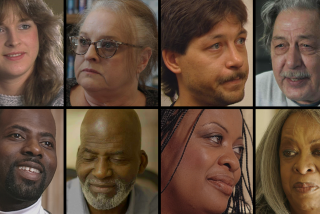Poor finally got their 15 minutes
- Share via
NEW YORK — Katrina introduced the nation’s Haves to the sight of its Have-nots.
A hurricane was needed (plus the blundering emergency response) to remind us that every resident of New Orleans couldn’t simply jump into his SUV and flee to higher ground.
Then, with the awful aftermath unfolding, a hapless cast of thousands seized TV’s attention on a scale never matched before by the underclass -- Americans disproportionately poor and black who paid a terrible price for the exposure. But when, if ever, will they be seen again? What -- besides some new, unimaginable crisis -- could repeat for them that level of acknowledgment by TV, whose default mode is the comfortably mainstream?
Consider the broadcast networks’ lineup of 31 new fall prime-time series. Only three have even nodding acquaintance with a lifestyle where material sufficiency isn’t assumed, where people teeter on the edge.
NBC’s reality series “Three Wishes” (which premieres Friday) dispatches singer Amy Grant to small-town America, where she and a team of good Samaritans lend a hand to ordinary folks in need of a boost (an injured girl’s family has crushing medical bills; a high school coach dreams of fixing the muddy football field).
UPN’s sitcom “Everybody Hates Chris” (premiering Thursday) revisits the childhood of comedian Chris Rock. Growing up in Brooklyn circa 1982, young Chris confronts racism at the all-white high school he is bused to, while his father works two jobs to keep the family fed.
The only other new show that ventures beyond the socioeconomic comfort zone is NBC’s comedy “My Name Is Earl” (premiering tonight), whose cartoonish antihero is a paragon of poor white trash, even as he sets out to redeem himself for a life of madcap depravity.
This is the sort of guy who, in a drunken stupor, once met and married a woman without noticing she was six months’ pregnant. He tells of stealing a car from a one-legged woman and relieving himself in the back seat of a police cruiser.
If he weren’t imaginary, Earl would be right at home on “Jerry Springer” or “Cops,” TV’s defining showcases for the real-life hoi polloi. It’s pretty much the same, whether make-believe or real. On TV, anyone who falls below a certain economic threshold is ripe to be depicted as a caricature, if not an outright stooge.
Recall the 1970s sitcom “Good Times.” Although set in the Chicago projects with a black family struggling to make ends meet, it sacrificed its authenticity to mine easy laughs from its breakout character: jive-talking J.J., with his clownish catchphrase, “Dy-no-mite!”
But the ghetto holds scant interest for TV anyway. Television prefers a middle-class pleasure dome outfitted with a penthouse for the fabulously well-heeled (these days, it’s Donald Trump who occupies the J.R. Ewing suite).
Never mind that this sanctuary of TV affluence clashes sharply with 2005 census figures that show 37 million people living under the poverty line.
Indeed, a team of “compensation experts” at the Salary.com website recently analyzed a sampling of 60 TV fathers from series spanning the last six decades. They found today’s fictitious breadwinners command an average annual salary of $195,000 -- more than twice the salary of their 1950s counterparts, who averaged $75,000 (in 2005 dollars).
So what? Austerity clashes with the mission of TV: getting people to buy stuff. People seen on TV are meant to be role models, consumers who insist on treating themselves to the products and lifestyles advertising celebrates.
In short: TV is aspirational, not representational. At least until Katrina struck. Then TV got terribly representational as the victims’ misery was captured by news cameras -- faces by the score seen frightened or enraged; bodies seen abandoned on an overpass or floating in floodwaters.
“Those who got out are fine,” Homeland Security chief Michael Chertoff told Tim Russert on NBC’s “Meet the Press.”
“But that’s the point,” Russert argued. “Those who could not get out were the poor, who rely on public buses to get out.” Once that huge hurricane had been forecast, “why weren’t buses, trains, planes, cruise ships, trucks provided on Friday, Saturday, Sunday to evacuate people before the storm?”
The answer is simple: Those people were invisible, unseen until too late. Then, shocking its audience and maybe itself, TV discovered them -- if only for a while.
More to Read
The complete guide to home viewing
Get Screen Gab for everything about the TV shows and streaming movies everyone’s talking about.
You may occasionally receive promotional content from the Los Angeles Times.






